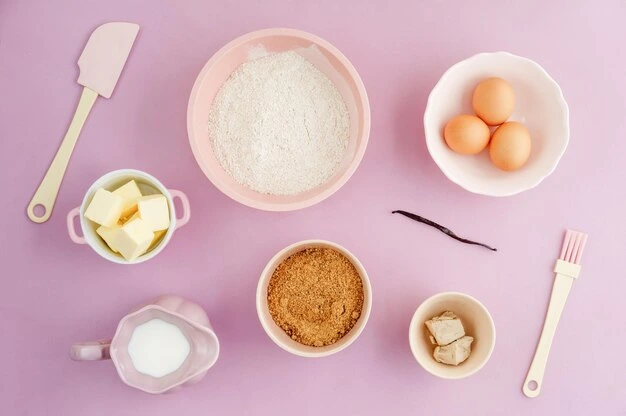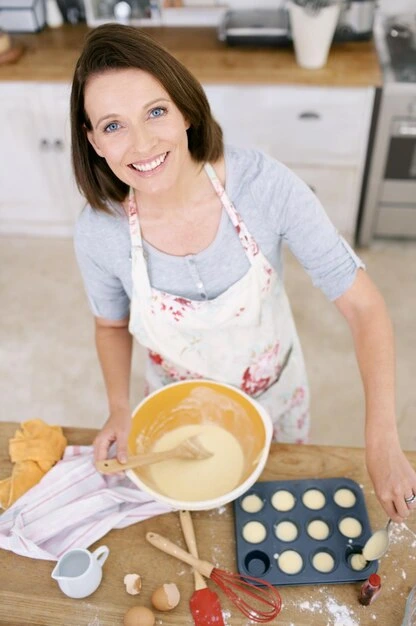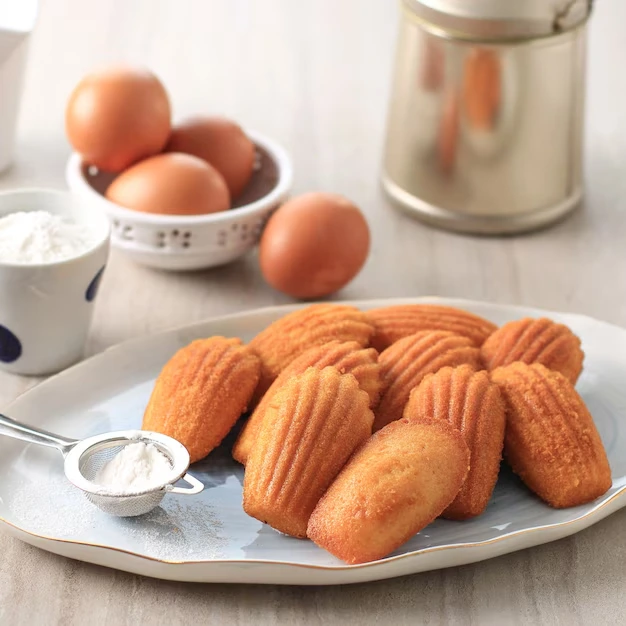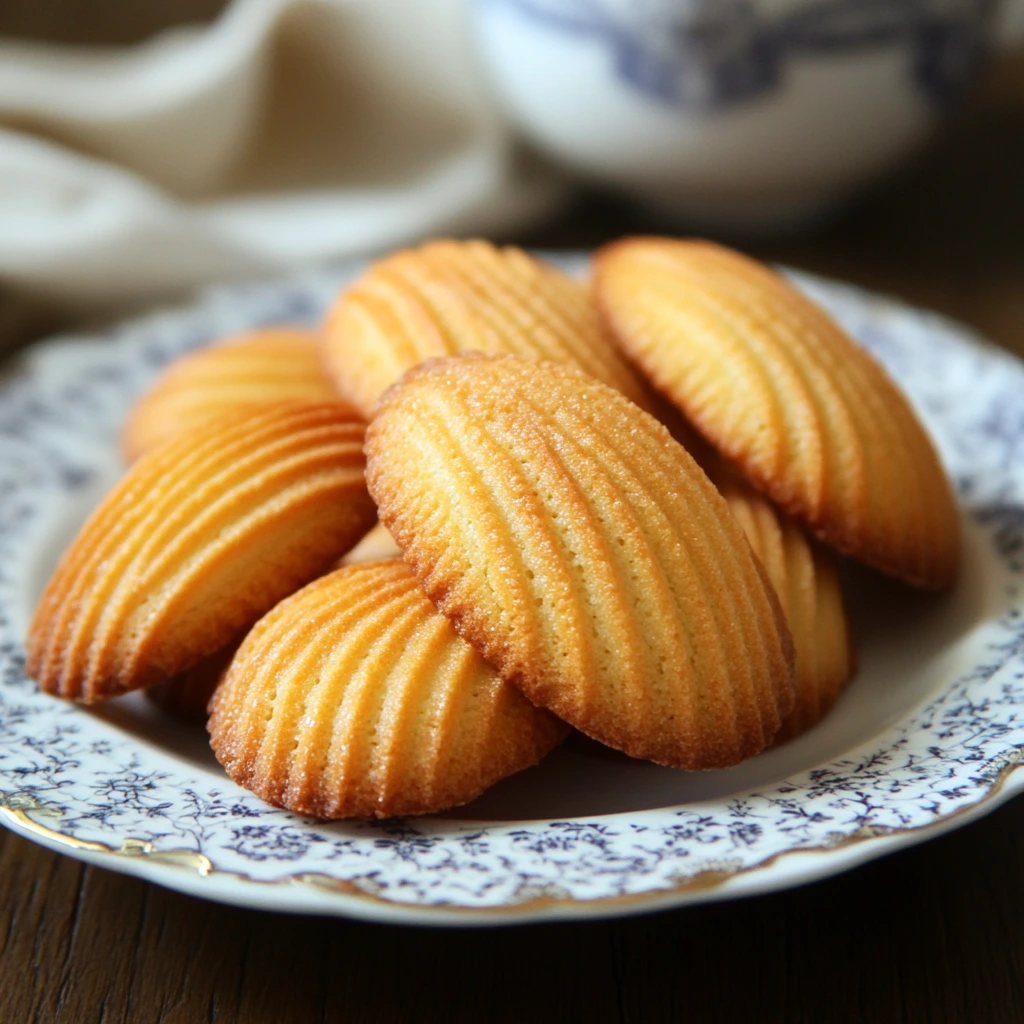(Easy Madeline Cookies Recipe) Madeleines are delicate, buttery French pastries that are beloved for their light, airy texture and unique shell shape. While they may seem fancy, this easy Madeleine cookie recipe allows you to create these delicious treats in just 30 minutes, making them perfect for any occasion. Whether you’re a beginner baker or just looking for a quick, satisfying dessert, these Madeleines will impress with their classic French charm. With only a few simple ingredients, you’ll be able to enjoy the authentic taste of Madeleines from the comfort of your own kitchen. So, get ready to bake up a batch of these irresistible cookies – it’s easier than you think!

What Are Madeleines?
Madeleines are small, shell-shaped cakes that are traditionally served as a French pastry. Known for their light, airy texture and rich buttery flavor, these delightful treats are often enjoyed with a warm cup of tea or coffee. Their distinctive shell shape, which comes from baking in a special Madeleine pan, gives them a unique visual appeal.
Origin and History:
Madeleines have a rich history, often associated with the Lorraine region of France. According to popular legend, they were named after a young woman named Madeleine who worked in the court of King Louis XV. It’s said that she introduced the king to these delicious little cakes, and they became so beloved that they were named in her honor. While the exact origins remain a bit unclear, their connection to French culinary tradition is undeniable.
Classic Recipe vs. Modern Variations:
Traditional Madeleines are made with simple ingredients like butter, sugar, eggs, and flour, and they are flavored with vanilla or lemon zest. Over time, however, variations have emerged, incorporating everything from chocolate to orange blossom water. Some bakers even experiment with adding fillings like fruit preserves or cream. While these modern twists add creative flair, the classic recipe remains a staple in French pastry shops and home kitchens.
Why They’re So Popular:
Madeleines are beloved not only for their delicate flavor and texture but also for their versatility. They are often considered the perfect accompaniment to tea time, and their compact size makes them ideal for snacking. The slight crunch on the outside combined with a soft, buttery center creates a satisfying bite that has won the hearts of pastry lovers worldwide. Despite their simple ingredients, the combination of a golden-brown exterior with a moist interior makes them a universally appealing treat.

Key Ingredients for Perfect Madeleines
Madeleines may have simple ingredients, but the combination and balance of these elements are what make them so special. Understanding the role each ingredient plays is key to creating the perfect batch of Madeleines. Here are the essential ingredients that go into making these delicate French pastries:
1. All-Purpose Flour
Flour is the base of any cake or cookie recipe, and for Madeleines, all-purpose flour works perfectly. It provides structure without making the texture too heavy. The flour should be sifted before mixing to prevent clumps and ensure a smooth, even batter.
2. Baking Powder
Baking powder is essential for achieving the light, airy texture of Madeleines. It helps the batter rise during baking, creating the perfect balance of softness and a slightly crisp exterior. Don’t confuse it with baking soda, as they are not interchangeable.
3. Eggs
Eggs are crucial for providing structure, moisture, and richness to the batter. They help bind the ingredients together and give the Madeleines their fluffy interior. Beating the eggs with sugar until they are light and frothy is an important step in achieving the ideal texture.
4. Butter (Unsalted)
Butter is the star ingredient that gives Madeleines their signature rich, buttery flavor. It also helps create that tender crumb. Always use unsalted butter to control the amount of salt in the recipe. Melt the butter before mixing, allowing it to cool slightly so it doesn’t affect the consistency of the batter.
5. Granulated Sugar
Sugar adds sweetness and helps with the golden-brown color of the Madeleines. It also contributes to the delicate crispness on the outside. Some recipes may use powdered sugar for a finer texture, but granulated sugar is the most common.
6. Vanilla Extract
Vanilla extract adds a subtle yet essential flavor to Madeleines, enhancing their sweetness and balancing the richness of the butter. While some variations use other flavorings like almond or orange zest, vanilla is the classic choice and gives the Madeleines their signature aromatic taste.
7. Lemon Zest (Optional)
Lemon zest is a popular addition for those who want to add a hint of brightness to the Madeleines. The zesty citrus flavor complements the buttery texture, creating a fresh contrast. It’s not essential, but it’s a lovely variation for a more complex flavor profile.

Step-by-Step Instructions for Making Madeleines
Making Madeleines might seem intricate at first, but with these clear, easy-to-follow steps, you’ll be baking like a pro in no time. Here’s how to create perfect, buttery Madeleines in under 30 minutes:
Step 1: Prepare the Madeleine Pan
Before you start mixing, prepare your Madeleine pan by greasing each mold with butter and lightly dusting with flour. This ensures that the Madeleines won’t stick to the pan during baking. If you have a non-stick Madeleine pan, you can skip the flouring step, but it’s always a good idea to grease the molds thoroughly. Alternatively, you can also use a baking spray that includes both flour and oil.
Step 2: Sift the Dry Ingredients
In a medium bowl, sift together the all-purpose flour, baking powder, and salt. Sifting is important because it removes any clumps in the flour and helps the dry ingredients mix evenly. This step ensures a smooth batter with no lumps that could affect the texture of your Madeleines.
Step 3: Beat the Eggs and Sugar
In a large bowl, beat the eggs and granulated sugar together using an electric mixer or whisk until the mixture becomes light, fluffy, and pale in color. This usually takes about 2-3 minutes with an electric mixer. The air incorporated during this step will help the Madeleines rise and give them their characteristic light texture.
Step 4: Add the Vanilla and Lemon Zest
Once your egg and sugar mixture is light and airy, add the vanilla extract and lemon zest (if using). The vanilla will give your Madeleines that classic flavor, while the lemon zest adds a subtle, refreshing hint of citrus that pairs wonderfully with the buttery texture.
Step 5: Fold in the Dry Ingredients
Now, gently fold the sifted dry ingredients into the egg mixture using a spatula. Be careful not to overmix, as this can deflate the airy texture you’ve just created. Use a folding motion to incorporate the flour without losing too much air from the egg mixture.
Step 6: Incorporate the Melted Butter
Melt the butter in a saucepan or microwave, then let it cool slightly. Gradually add the melted butter to the batter and gently fold it in. The butter will add richness and flavor to the Madeleines, and it should blend seamlessly into the batter. Avoid over-mixing to maintain a light texture.
Step 7: Let the Batter Rest
Once the batter is fully mixed, cover the bowl with plastic wrap and refrigerate it for about 15-20 minutes. Chilling the batter helps the Madeleines hold their shape during baking, creating that iconic hump in the middle.
Step 8: Preheat the Oven
While the batter rests, preheat your oven to 375°F (190°C). A properly preheated oven is crucial to achieving that perfect golden-brown crust on your Madeleines.
Step 9: Spoon the Batter into the Pan
After the batter has rested, spoon it into the prepared Madeleine pan. Fill each mold about three-quarters full, as the batter will rise and spread slightly during baking. You can use a spoon or a piping bag for cleaner filling, but a spoon works just fine.
Step 10: Bake the Madeleines
Place the filled pan in the preheated oven and bake for about 10-12 minutes. The Madeleines should be golden brown on the edges and slightly puffed in the center. You can check for doneness by inserting a toothpick into the center of one of the cakes – it should come out clean when they’re fully baked.
Step 11: Cool the Madeleines
Once baked, remove the Madeleines from the oven and let them cool in the pan for about 2 minutes. Afterward, carefully turn them out onto a wire rack to cool completely. If you have trouble removing the Madeleines, gently run a butter knife around the edges of each mold.
Step 12: Optional – Dust with Powdered Sugar
For an elegant touch, dust the cooled Madeleines with powdered sugar. This step is optional but adds a nice visual finish, especially if you’re serving them for a special occasion or tea time.

Troubleshooting Common Madeleine Issues
Despite how simple they seem, Madeleines can sometimes present a few challenges. However, with some attention to detail and a bit of patience, you can easily fix any issues that arise. Here are some common problems you might encounter when making Madeleines and how to solve them:
1. Dense Madeleines
If your Madeleines turn out dense instead of light and airy, it could be due to a few different factors:
- Overmixing the Batter: Overmixing the batter after adding the dry ingredients or melted butter can cause the air bubbles created by beating the eggs to collapse. This leads to a denser texture. Make sure to fold the ingredients gently, and stop mixing once everything is combined.
- Not Beating the Eggs Enough: The key to light Madeleines is to beat the eggs and sugar until they’re fluffy and pale. If the eggs aren’t aerated enough, the batter won’t rise properly during baking. Be sure to beat the eggs for at least 2-3 minutes until they’re light and frothy.
- Incorrect Oven Temperature: Baking at a temperature that’s too low can result in under-risen, dense Madeleines. Ensure your oven is preheated to the correct temperature (375°F or 190°C), and use an oven thermometer if necessary to confirm the temperature is accurate.
Solution: Be gentle when mixing, beat the eggs sufficiently, and double-check your oven temperature for accuracy.
2. Madeleines Sticking to the Pan
Madeleines are notoriously tricky when it comes to releasing from the pan, especially if the pan is not properly prepared.
- Not Greasing the Pan Properly: If you skip or rush the process of greasing and flouring the pan, the Madeleines will stick to the mold, making it hard to remove them.
- Using the Wrong Pan: Non-stick Madeleine pans are ideal for easy release. If you don’t have a non-stick pan, be extra generous with the butter and flour to avoid sticking.
Solution: Make sure to properly grease and flour the Madeleine pan, or use a non-stick pan if you have one. You can also use baking spray with both oil and flour.
3. Underbaked or Overbaked Madeleines
Getting the perfect bake on Madeleines can be tricky, as they need to be golden brown with a soft, tender center.
- Underbaked Madeleines: If the Madeleines are underbaked, they might be pale or soggy in the middle. This can happen if you take them out of the oven too soon.
- Overbaked Madeleines: On the other hand, if they’re left in the oven for too long, they can become dry or overly browned, losing their signature soft crumb.
Solution: Start checking for doneness around 10 minutes, but it may take up to 12 minutes depending on your oven. The Madeleines should have a golden-brown exterior and a slightly firm texture when touched. If you’re unsure, use a toothpick to test for doneness – it should come out clean when the Madeleines are ready.
4. Flat Madeleines (No Hump)
One of the signature features of a Madeleine is the characteristic hump that forms in the center during baking. If your Madeleines come out flat, it’s usually due to one of these issues:
- Batter Not Chilled: Chilling the batter before baking is a crucial step. If the batter isn’t cold enough, the Madeleines won’t rise properly and will come out flat.
- Not Enough Leavening: The baking powder is responsible for giving the Madeleines their rise. If you didn’t use enough, or if the baking powder is too old and inactive, your Madeleines might not rise properly.
Solution: Always chill the batter in the fridge for 15-20 minutes before baking, and make sure your baking powder is fresh and properly measured.
5. Uneven Color (Pale Bottoms or Tops)
If your Madeleines are unevenly browned, with one side paler than the other, this can be due to the heat distribution in your oven.
- Oven Hot Spots: Some ovens have hot spots that can cause uneven baking, leading to one side of the Madeleines being overbaked while the other remains underbaked.
- Improper Placement in the Oven: Placing the Madeleine pan too high or too low in the oven can cause uneven baking. If the pan is too close to the top or bottom heating element, the Madeleines might not cook evenly.
Solution: Position your Madeleine pan in the center of the oven for even heat distribution. If you suspect your oven has hot spots, rotate the pan halfway through baking to ensure an even bake.

Serving and Storing Madeleines
Madeleines are best enjoyed fresh, but they can also be stored for later enjoyment. Whether you’re serving them for a special occasion or enjoying them as an everyday treat, knowing the best ways to serve and store these delicate cookies ensures you get the most out of your batch.
1. Best Ways to Serve Madeleines
Madeleines are incredibly versatile and can be served in various ways, depending on your occasion or personal preferences. Here are some popular options for serving these buttery treats:
- With Tea or Coffee: The classic way to serve Madeleines is alongside a hot cup of tea or coffee. The light, tender texture of the Madeleines pairs beautifully with the warmth of your favorite beverage. Try pairing them with Earl Grey, black tea, or even a milder herbal tea like chamomile.
- For Breakfast or Brunch: Madeleines can be a delightful addition to breakfast or brunch. Their small size makes them easy to serve with other breakfast treats like fresh fruit, yogurt, or croissants.
- As a Dessert: Serve Madeleines as a light dessert after a meal. They can be dusted with powdered sugar for an elegant touch or paired with fresh berries or whipped cream for a more indulgent treat.
- At Special Occasions: Madeleines are perfect for special occasions like afternoon tea parties, birthdays, or holiday gatherings. Their delicate appearance and rich flavor make them a sophisticated treat that guests will love.
2. Storing Madeleines
While Madeleines are best enjoyed fresh, you can store them for a few days to enjoy later. Here are some tips for keeping your Madeleines fresh:
- Room Temperature: To store Madeleines for up to 2-3 days, keep them in an airtight container at room temperature. Be sure to let them cool completely before storing to avoid condensation, which could make them soggy.
- Keep Them Separate: If you plan to store a batch of Madeleines for a few days, it’s important to layer them in the container with parchment paper between each layer to prevent them from sticking together.
- Avoid Refrigeration: Madeleines should not be refrigerated, as the cold air can affect their soft texture. Storing them in the fridge may cause them to dry out and lose their signature moisture.
3. Freezing Madeleines
Madeleines freeze well, allowing you to make them ahead of time and enjoy them at a later date. Freezing is a great option if you want to bake in bulk or simply keep a batch on hand for when cravings strike. Here’s how to freeze Madeleines:
- Freezing Before Baking: If you want to freeze the batter, spoon it into the Madeleine molds and freeze the pan for about 1-2 hours. Once the batter is firm, pop the Madeleines out of the pan and store them in a freezer-safe container or bag. When you’re ready to bake, preheat the oven and bake the frozen Madeleines as directed, adding an extra minute or two to the baking time.
- Freezing After Baking: To freeze baked Madeleines, allow them to cool completely before wrapping them tightly in plastic wrap or placing them in an airtight container. They can be stored in the freezer for up to 1-2 months. When you’re ready to enjoy them, thaw the Madeleines at room temperature for about 20-30 minutes, or warm them gently in the oven for 5 minutes to refresh their texture.
4. Reviving Madeleines
If your stored Madeleines begin to lose their freshness, you can easily revive them:
- Warming Them: If the Madeleines have become slightly stale or lost their original softness, simply warm them in the oven for 5 minutes at 350°F (175°C). This will bring back some of their freshly baked texture and aroma.
- Freshening with Butter: For an extra indulgent treat, you can brush the Madeleines with melted butter before serving. This adds richness and moisture, making them taste freshly baked again.
Conclusion
Making Madeleines is a rewarding and enjoyable experience that brings a touch of French elegance to your kitchen. With just a few simple ingredients and easy-to-follow steps, you can create these light, buttery treats in no time. Whether you enjoy them with a warm cup of tea, serve them as a delightful dessert, or savor them as a snack, Madeleines are sure to become a favorite in your baking repertoire.
By understanding the key ingredients, following the step-by-step instructions, and troubleshooting any common baking issues, you’ll be able to perfect your Madeleines every time. And, with the right serving and storage tips, you can enjoy these delicious pastries fresh or save them for later.
So why wait? Try your hand at making Madeleines today and bring a little piece of French pastry magic into your home. Bon appétit!
Best Madeleines (French Butter Cakes) Recipe
Chicken and Cheese Jalousie Recipe – Crispy, Cheesy & Irresistible! – labelrecipes.com

